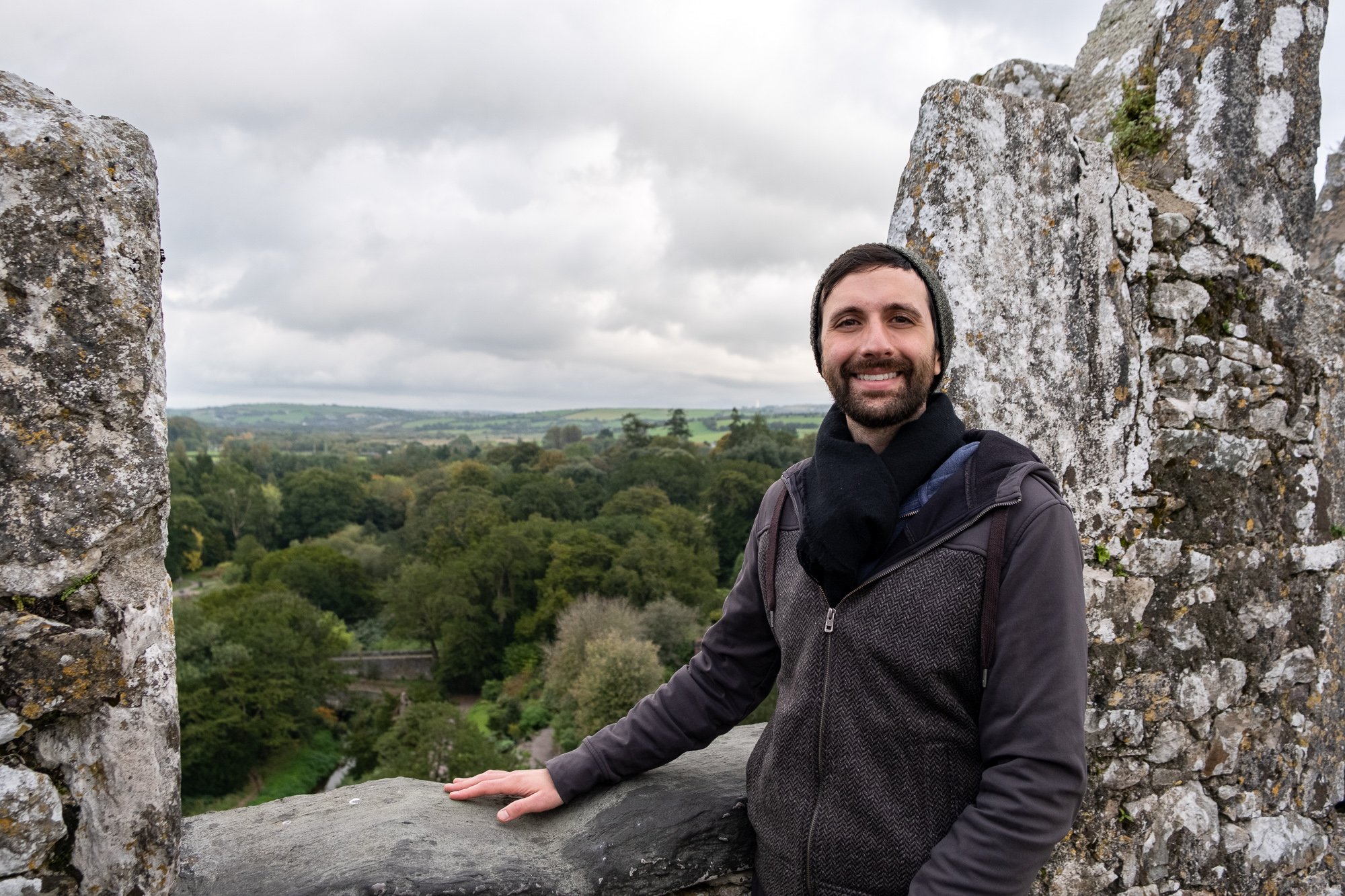Tech and Gear for Long-Term Travel in Cities
I discovered a new term that describes our travel style: flashpacking. It’s basically grown-up backpacking. A backpacker is traditionally younger, has a shoestring budget, and stays in hostels. Picture hauling giant packs through Southeast Asia in cargo pants and washing quick-dry underwear in the sink. On the other hand, a flashpacker has the same explorer spirit, but is typically in their 30s or 40s and slightly less frugal. Many are former backpackers now balancing adventure with comfort. They may prefer to stay in AirBnbs, take a train or plane instead of a bus, or shell out for nicer meals. As opposed to a tourist, who is on vacation, both backpackers and flashpackers travel light, local, longer term, and independently (vs. with a tour group). However, they have differing priorities and resources.
You can read about how we’re packing light with clothing and chasing mild fall weather for this six-month career break. One of the most common questions we’ve gotten as we prepare is, “What are you bringing?” We made some tough decisions about what we think we’ll need to make the most of our time. There were various weight and size restrictions to consider. Luckily, we’re not digital nomads working full-time jobs or professional travel bloggers, so we don’t need too much gear. We’re also not going to be anywhere remote, so we can also easily pick up things we need. Each of us brought just one backpack (mine is an everyday 27L, Ben’s is the 39L expandable Knackpack) and one international carry-on sized duffel (about 37L).
Tech Trifecta: Laptop, Camera, Phone
Macbook Air plus charger, adapter, and external hard drive (shared with Ben)
Mirrorless digital camera Fujifilm X-S10 with 18-55mm kit lens plus memory cards and an extra battery (shared with Ben)
The best camera is the one you’ll use. We were ready to downsize from our bulky Canon Rebel T1i DSLR with multiple heavy lenses. After extensive research (a favorite pastime of mine), we chose the Fujifilm X-series. Our model was the newest at the time and had glowing reviews about a comfortable hold and improved features. One of my top priorities was small and light (the body weighs just over 1 pound) to encourage frequent use. It has an APS-C compact sensor, in-body image stabilization, great video, and lots of lens options (although we’re just bringing the one wide angle).
If you’re a smartphone photographer who wants to venture into the camera world, you could try a “compact” mirrorless camera with a fixed lens. I was very close to getting the Panasonic Lumix LX100 II. The 24-75mm digital zoom lens retracts into the body, so it feels like a large point-and-shoot. It’s easy-to-use and super light, and will probably give you better images than what you’ve been using. On the flip-side, if you want a mirrorless camera that's a bit more robust than ours, my top picks were the Sony A6600 and the Sony A7 IV.
Smartphones: Some long-term travelers use unlocked phones and buy local SIM cards at each destination. We have T-Mobile specifically for their international plan, which connects us to the local network wherever we are with unlimited data up to 2G speeds, no roaming fees, free unlimited texting, and free wi-fi calling.
Check out this comprehensive list of online travel tools and here are our essential free apps on the road:
Google Maps: download an offline map of the local area ahead of time
Google Translate: download specific language dictionaries ahead of time
WhatsApp: text, call, or video chat anyone anywhere in the world via wi-fi, extremely widespread in Europe
Lightroom: powerful and quick mobile photo editing - there’s a free version!
Relax Melodies: white noise for better sleep
Too Good To Go: we just discovered this from a German Workawayer. It’s popular in Europe and has started to spread to larger cities in the US. Eating establishments that have excess or leftover food sell at a steep discount. We tried it in Copenhagen and it’s a fun way to get food on the cheap and find places in a new city.
Fun, Creativity, and Wellness
Kindle Paperwhite e-readers: I strongly prefer paper books, but I can’t just stop reading while on the road!
Manduka Eko Superlite Travel Yoga Mats: We decided that keeping up our regular practice (shout out to Yoga with Adriene) was worth it. These fold up flat and weigh less than 2lb - a worthy trade-off for the physical and mental health benefits. They’re super thin at only 1.5mm, so to save our knees we cut strips off a cheap 5mm yoga mat to make DIY knee pads.
I started teaching myself to paint and draw last summer. It’s been a relaxing hobby and good creative outlet. I knew it was something I wanted to do to enhance my travel experience and record what we see and do.
Small lined notebook: my analog journal, for notes and more of a day-to-day log than this blog.
Small soft-bound sketchbook, three pens, and my DIY travel sketching kit (an Altoids tin filled with mini colored pencils, golf pencil, sharpener, and eraser)
Small watercolor journal, two brushes, a water brush, and my travel palette gifted by a friend and filled with my paint tubes from home
Just-in-Case
Very few back-up items made the cut. They had to be as small and light as possible. We’ll be in cities and small towns, and we’re not camping or staying anywhere remote. So, we opted out of backpacker tools like water purification, laundry lines, soap sheets, mosquito nets, headlamps, duct tape, toilet paper, microfiber towels, etc.
Thin canvas tote bag (for groceries or a beach bag)
Ultralight fold-up day pack
2-in-1 whistle/compass (I always have this on me for safety)
Super light digital luggage scale (to avoid surprise overweight penalties at the airport counter)
Ear plugs and eye mask
International driving permits (cheap and simple to get through AAA - some countries require them to rent cars)
Gadgets & Toiletries
Headphones (we each splurged on a noise-canceling pair), earbuds, and a headphone splitter
Universal international plug adapter
Portable power banks (our #1 most-used items)
Toiletries: We’re keeping personal hygiene super minimal. You may not be surprised to hear that months before our trip, I started keeping track of how long it took me to go through my everyday products and basic makeup. That way, I could estimate how much to bring of each. We’re keeping it to daily staples only, as many things in solid form as possible - no hair styling tools or extra skincare. We’ll be shopping at drugstores throughout our journey.
Toiletry bags: super lightweight with a few mesh internal pockets, made of nylon, and they can hang open from hooks
Travel Basics
Passports (luckily US citizens don’t need visas to visit the Schengen Zone, Australia, or most other European countries for up to 90 days within a 6-month period - I just need to track my time)
Vaccination booklets and COVID vaccine cards (we also got the EU COVID digital certificate app when we arrived at a German pharmacy)
Face masks (easy to pick up along the way, we brought 3 cloth ones each but much of Europe requires “medical” masks: KN95 or surgical)
Credit card with no international transaction fees and some cash
A few key medications (although most non-prescription drugs are easy to find in European pharmacies)
Reusable water bottles (here’s a handy infographic of where in the world it’s generally safe to drink from the tap)
Health, Safety, and Security Considerations
Travel insurance: Not only does our policy cover mishaps like stolen property and canceled flights, but it also serves as our health insurance. We chose SafetyWing because it was well-reviewed, affordable month-to-month, and includes COVID quarantines. World Nomads also comes highly recommended.
VPN (Virtual Private Network): A low price to protect our data whenever we connect to unfamiliar wi-fi… which will be always. All of our devices are covered by simply logging into a convenient app. We got NordVPN.
STEP (Smart Traveler Enrollment Program): We update our online profiles in each new country so the US State Department knows where to find us in case of emergency. We also look up the location of the nearest American consulate and jot down the address and phone number on paper wherever we are.
Sherpa: an extremely useful website that details current COVID travel restrictions. We plug in the country we’re departing from and the country we’re entering and it tells us whether we need proof of vaccines, negative tests, or both, and also links to any online passenger locator forms or other documents to fill out.






